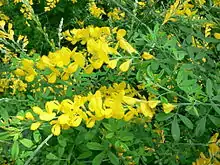| Genista stenopetala | |
|---|---|
 | |
| Scientific classification | |
| Kingdom: | Plantae |
| Clade: | Tracheophytes |
| Clade: | Angiosperms |
| Clade: | Eudicots |
| Clade: | Rosids |
| Order: | Fabales |
| Family: | Fabaceae |
| Subfamily: | Faboideae |
| Genus: | Genista |
| Species: | G. stenopetala |
| Binomial name | |
| Genista stenopetala | |
| Synonyms[1] | |
| |
Genista stenopetala, the sweet broom, Easter broom or leafy broom (syn. Genista spachiana, Cytisus spachianus), is a species of flowering plant in the legume family Fabaceae, native to the Canary Islands, on La Palma and Tenerife.
It is an evergreen shrub growing to 3 metres (9.8 ft) tall. The leaves are trifoliate, the leaflets 1–3 centimetres (0.39–1.18 in) long, narrow elliptic, coated with fine silky, silvery hairs. The strongly scented flowers are yellow, 1–2 centimetres (0.39–0.79 in) long, produced in racemes 5–11 centimetres (2.0–4.3 in) long. The flowers appear in late winter or early spring.[2] The fruit is a pod 2–3 centimetres (0.79–1.18 in) long.
The Latin specific epithet stenopetala means "with narrow petals".[3]
Under the name Genista × spachiana, it has won the Royal Horticultural Society's Award of Garden Merit.[2] It is not a hardy plant, and does not tolerate temperatures below 5 °C (41 °F), so in temperate climates it is usually grown under glass. However, it may be placed outside during the summer months, in a sheltered, sunny spot.[2]
References
- ↑ "Genista spachiana Webb | Plants of the World Online | Kew Science". Plants of the World Online. Retrieved 7 July 2021.
- 1 2 3 "Genista × spachiana". www.rhs.org. Royal Horticultural Society. Retrieved 9 July 2020.
- ↑ Harrison, Lorraine (2012). RHS Latin for Gardeners. United Kingdom: Mitchell Beazley. ISBN 184533731X.
- Huxley, A., ed. (1992). New RHS Dictionary of Gardening. Macmillan.